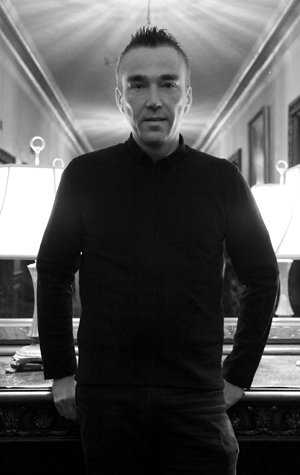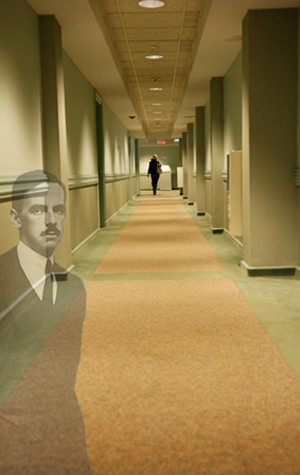Ghosts of Boston
Alum’s new book covers Hub’s history of hauntings

For someone who often encounters dead people, Sam Baltrusis seems remarkably calm.
“People have the misconception that the paranormal is negative, but in my experience, it’s actually been the opposite,” says Baltrusis (COM’93).
A journalist who has worked for ABC Radio, MTV, Stuff Magazine, and Boston Spirit Magazine and whose blog “Loaded Gun” covers the Beantown movie boom, Baltrusis says he has personally encountered five or six ghosts, some inhabiting apartments he has lived in, and one near the notoriously haunted Fort Warren on Boston’s Georges Island, in 2007.
Baltrusis first pitched the idea of writing an article on ghosts in Boston to Stuff Magazine, eventually amassing enough material for a book. Ghosts of Boston: Haunts of the Hub was published last month by the History Press.
The book explores the city’s ghoulish history over more than three centuries, including Colonial-era spirits said to still roam Boston Common and those of 100 British soldiers killed during the Revolutionary War, whose remains were discovered during the building of the Boylston T station in the early 20th century—some of them allegedly haunt Boston’s subway tunnels.
“A lot of these people have stories to tell, and as a journalist it’s my job to give a voice to people who don’t have a voice,” Baltrusis says. “I just didn’t realize they were going to be dead.”
Baltrusis, a teacher of writing and journalism at the Boston Center for Adult Education, recently taped a special for the Biography Channel’s Haunted Encounters, where he examined the “residual energy” that he says still lingers from the 1897 gas-line explosion near the corner of Boylston and Tremont Streets that killed 6 and wounded more than 60 people.
BU Today spoke with Baltrusis about his experiences with ghosts and paranormal happenings in Boston and about BU’s own haunted history.
BU Today: Tell us about your first encounter with a ghost.
Baltrusis: I was living in Ball Square in Somerville. I saw what looked like a little girl coming out of the closet. I was shocked, but my roommates said they had already seen her. I kept seeing what looked like the shape of a girl peeking out of the closet, and I just accepted that the place was haunted. We also heard footsteps, and whenever I would go to check it out, nobody was there.
You write in the book that you currently live with a female spirit.
I live near Davis Square in Somerville, and things like scissors kept going missing from the house. I do a lot of craft projects, and I noticed the cabinets would open, the doors would open, and there were a lot of noises. I saw what looked like a female figure walking by in a nightgown, so my roommate and I started calling her the scissor sister. I definitely think she’s friendly, she’s playful, and I just accept that she’s here. She is probably a residual haunting, in the sense that she lived in the house and she continued staying in the house after she passed. And I think she’s definitely a happy haunter.
People may be surprised to learn how much of Boston’s history is rather dark.
Ghosts of Boston is in essence a history book with ghost stories in it; it’s a fun way to read about Boston’s history. I wanted to look at whether, if a place is allegedly haunted, there was a backstory as to why it may be haunted. For instance, if there was a fire, it might make sense for people to report hearing glass break or doors slamming or screams coming from a building. This comes into play with the 1942 Cocoanut Grove fire, which killed almost 500 people. Disasters, murder, suicide, those types of things linger in a building.

Talk about BU’s history with ghosts.
There is a whole historical backstory of playwright Eugene O’Neill and his last days spent at Shelton Hall [now Kilachand Hall], which is where I lived during my sophomore year at BU [O’Neill lived on the fourth floor, now known as the Writers’ Corridor, of what was then the Hotel Shelton, and and died there in November 1953]. I didn’t have any encounters with him, but I remember all of the RAs talking about the backstory and the Writers’ Corridor.
Some people think that the founder of the Repertory Theatre of Boston [now the BU Theatre, home of the Huntington Theatre Company] committed suicide in 1930 because the theater was failing—that’s not true. The book talks about how he actually died in his home, so there’s a lot of debunking in the book.
Actually, a lot of material that didn’t make it into the book was applicable to BU. One story involved Myles Standish Hall, and another 515 Park Drive in South Campus, which was the site where one of the Boston Strangler’s victims lived. The Charlesgate Hotel, which is now apartments, was an allegedly haunted location and used to be a dorm for Emerson and BU.
Your book emphasizes the surprisingly scientific methods of many paranormal investigators, who use such things as meters, thermometers, and digital cameras. Can you talk about this?
Adam Berry, whom I interviewed extensively for the book, is a paranormal investigator on SyFy’s Ghost Hunters. They actually use equipment that’s very science-based. It is used to find evidence for something that’s inexplicable. They are more skeptical. They go in with the idea that this place isn’t haunted, and they’re trying to find evidence to prove that it actually is haunted or that there’s some paranormal activity at the place.
How do you handle skeptics?
Researching and writing about ghost stuff is like coming out of the paranormal closet, because you have to talk about your own experiences with the spirit realm and with ghosts. It was a little difficult to get up in front of people and talk about my experiences with the spirit realm.
I get a lot of nonbelievers or naysayers, and I think that when people actually read the book they’ll find that it’s very well researched. I’m kind of like Mulder from The X-Files, the believer. My assistant, Andrew Warburton, who’s a PhD student at Tufts, is more like my Scully, the skeptic. We fought the whole time.
When I’ve done book signings I’ve seen the transformation in people. I realize as I meet people at my book signings and they tell me their stories, that it’s a great way to collect material for my next book.
What were some of your best sources for material?
My research assistant was fantastic. I’m also a tour guide with Haunted Boston, so I got a lot of stuff from actually giving those tours in the Boston Common. And then a lot of old newspaper clippings—those are important as original source material—and of course talking to people. I found that people in New England do not want to go on record, so it was difficult getting people to talk about their experiences with the paranormal on record.
You allude to your next book. What will that be about?
I just signed a contract to write a book about the ghosts of Cambridge, and I launched a ghost tour in Cambridge called Cambridge Haunts. I’d also like to pitch a book on the ghosts of Provincetown.

Comments & Discussion
Boston University moderates comments to facilitate an informed, substantive, civil conversation. Abusive, profane, self-promotional, misleading, incoherent or off-topic comments will be rejected. Moderators are staffed during regular business hours (EST) and can only accept comments written in English. Statistics or facts must include a citation or a link to the citation.